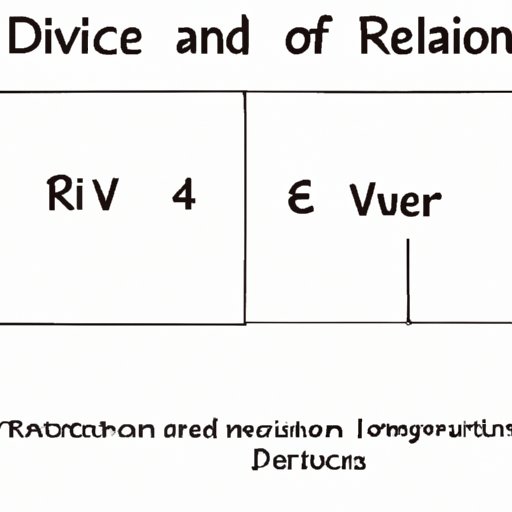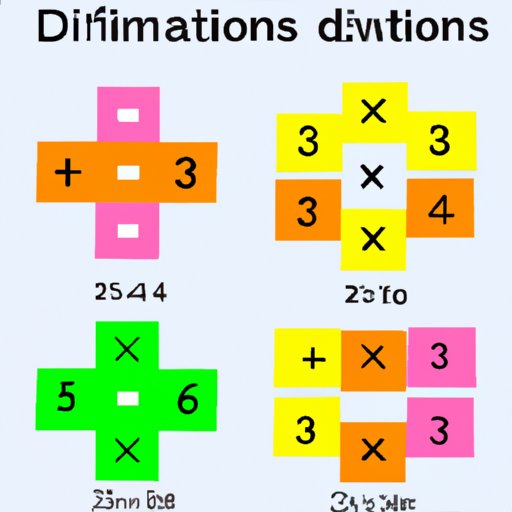I. Introduction
Have you ever struggled with dividing numbers, fractions, or other figures? Maybe you found yourself stuck on a complex calculation, unsure of the next steps. Or perhaps you felt intimidated by the vast array of terms, techniques, and tricks associated with division. Whatever your experience, learning how to divide is essential in many areas of life, from cooking to engineering to finance. With this beginner’s guide, you will gain the confidence, knowledge, and skill needed to tackle any division problem.
In this article, we will cover the fundamental principles of division, provide step-by-step instructions for dividing various numbers, explore common tricks and techniques for simplifying division, and examine real-world examples of division in action. We will also provide practice exercises to help you improve your division skills. By the end of this guide, you will be able to divide with ease and precision.
II. “7 Simple Steps to Divide: A Beginner’s Guide”
Before delving into more complex division techniques, it’s essential to understand the basic principles of division. Here is a simple seven-step guide to dividing two numbers:
1. Write the dividend (the number being divided) on the left side of the quotient (the answer), and the divisor (the number doing the dividing) to the left of it.
2. Estimate the answer by asking, “How many times does the divisor go into the first digit of the dividend?” Write that number above the dividend.
3. Multiply the divisor by the estimate and write it under the dividend, lined up with the rightmost digits of the dividend.
4. Subtract the product from the dividend.
5. Bring down the next digit of the dividend next to the result of the subtraction.
6. Repeat steps 2-5 until you have no more digits to bring down.
7. Check your answer by multiplying the quotient by the divisor and adding the remainder. The result should equal the dividend.
Let’s illustrate this process with an example: dividing 612 by 4.

As you can see, the quotient is 153, with no remainder. Thus, 612 divided by 4 equals 153.
III. “Divide and Conquer: Making Division Easier”
While the basic seven-step approach to division works well with simple numbers, it can be time-consuming and tedious with larger figures or decimals. That’s where tricks and methods come in. Here are some techniques for simplifying division:
– Use multiplication: If you know that two numbers multiplied make the dividend, and one of those numbers is given, divide the given number by the other for the quotient.
– Example: Divide 630 by 14. 14×5=70 (less than 630) but 14×6=84 (greater than 630). Therefore, the quotient is 5.
– Round numbers: In some cases, you can round the dividend or divisor to the nearest ten, hundred, or thousand to make the calculation easier. Remember that you must do the same rounding for both numbers.
– Example: Divide 987 by 29. 30×30=900. Therefore, the quotient must be less than 30. 20×29=580. 987-580=407. 30×29=870. Therefore, the quotient must be greater than 20. 25×29=725. 987-725=262. Therefore, the quotient is 25.
IV. “Why We Divide: Understanding the Fundamentals”
Division is a fundamental mathematical concept that underpins many areas of everyday life. From baking a cake to calculating the interest on a loan, division helps us allocate resources, measure quantities, and make informed decisions. Here are some real-world examples of the relevance of division:
– Cooking: When following a recipe, we often need to divide or multiply ingredient quantities to suit the desired serving size. For instance, if a recipe calls for a cup of flour for six people, but you only need to serve two, you can divide the quantity by three.
– Finance: When managing a budget, we use division to calculate expenses, income, and savings. For example, if you get paid $1,500 per month and need to save 10% of the income, you can divide $1,500 by 10 to get the amount to save ($150).
– Science: In the physical and natural sciences, division is used to measure quantities or rates. For instance, when calculating the acceleration of an object, you divide the change in velocity by the change in time.
V. “How to Divide Fractions: Demystifying a Difficult Calculation”
Dividing fractions can be a daunting task, especially for beginners who are still getting used to the basic rules of fractions. But fear not! Here is a step-by-step guide to dividing fractions:
1. Flip the second fraction (the divisor) upside-down (take the reciprocal).
2. Multiply the first fraction (the dividend) by the flipped second fraction.
3. Simplify the answer by reducing any common factors.
Let’s illustrate this process with an example: dividing 2/3 by 3/5.

As you can see, the answer is 10/9 or 1 and 1/9.
VI. “Dividing Large Numbers: Techniques and Tricks”
Now, what about dividing larger numbers? This is where long division comes into play. Here are some tips and tricks for dividing big numbers:
– Long Division: Write the dividend and divisor in long division format, dividing the first digit of the dividend by the divisor. Perform subtraction. Step down to the next digit in the dividend. Write the remainder of that subtraction with the next digit of the dividend.
– Example: Divide 345432 by 234.

– Shortcut Methods: If the divisor is a multiple of 10, 100, 1000, etc., you can use a shortcut. Move the decimal point in the dividend to the left by the same number of zeroes as the divisor to remove the extra zeroes.
– Example: Divide 4572 by 100. The divisor is 100, so the decimal point of the dividend must move two places to the left. The answer is 45.72.

VII. “Division in Real Life: Examples and Applications”
Division is a ubiquitous operation used to solve problems across various domains, including business, engineering, medicine, and more. Here are some examples of how division is applied in various fields:
– Business: Companies use division to calculate profits and revenue, which help assess financial performance and make informed business decisions. For example, if a company has earned $100,000 in revenue over the past year but spent $50,000 on expenses, you can calculate the net income by dividing the difference ($50,000) by the revenue ($100,000) to get a ratio of 0.5 or 50%.
– Engineering: Engineers use division to calculate measurements such as velocity, force, and torque. For example, if a car travels 300 miles in 5 hours, you can calculate the average speed by dividing the distance by the time to get 60 miles per hour.
– Medicine: Medical professionals use division to calculate dosages for medications and interpret lab test results. For example, if a patient’s lab test shows a certain chemical is present at 0.001 parts per million, you can calculate the actual amount of chemical present by dividing the concentration by the volume of the sample used to test it.
VIII. “Mastering Division: Practice and Exercises”
To master division, like any skill, takes practice. Here are some practice problems and exercises to help you get comfortable with and proficient at dividing:
1. 20/4
2. 147/6
3. 1,634/7
4. 3,120/15
5. 32,567/97
6. 0.7/0.05
7. 4/9 * 2/3
8. 3/4 / 2/5
9. (5/6) / (7/8)
10. 9/11 / 18/22
Answers:
1. 5
2. 24.5
3. 233.43
4. 208
5. 335.31
6. 14
7. 8/27
8. 15/8
9. 20/21
10. 22/33
IX. Conclusion
Dividing numbers, fractions, and large figures can be challenging, but with the right tools and techniques, it becomes a manageable task. In this article, we have covered the basic principles of division, types of division tricks, applications in various fields, and ways to practice division techniques. Whether you’re cooking a meal, budgeting your finances, or solving complex engineering problems, division is a valuable tool that can help you achieve your goals with confidence.
